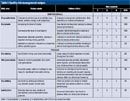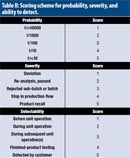PQRI Case Study (1): Defining Process Design Space
A PQRI expert working group provides case study examples of risk-management applications.
This case study on process design space is the first of eight in a series put together by the Product Quality Research Institute Manufacturing Technical Committee (PQRI–MTC) risk-management working group. The series is meant to advance the understanding and application of the International Conference on Harmonization (ICH) Q9 Quality Risk Management guideline by providing actual examples of risk-management assessments used by the bio/pharmceutical industry. The introductory article and first case study, on defining design space, appears in the July 2011 issue of Pharmaceutical Technology).
Risk assessment of the manufacturing process is a key activity in product development, especially as a supportive tool in quality by design (QbD). In this case study, a drug product was formulated with different variants, each with a different dissolution profile ranging from slow to fast. While an in vitro–in vivo correlation (IVIVC) evaluation was not possible due to product-specific pharmacokinetic factors, the profiles of all of the formulations were similar. The dissolution method was already known to be over-discriminatory and the slowest dissolution profile from the range of formulation variant studies was set as the slowest dissolution profile acceptable. This profile would serve as the surrogate test for the quality of the clinical product in processing studies. In other words, the design space for clinical quality would be a product with a faster dissolution profile than the slowest variant. To ensure a full understanding of all potential influences to the design space, a full risk assessment of the manufacturing process was conducted to ensure that areas of greatest risk were appropriately considered and controlled.
Risk question and risk-assessment method
The risk question developed for the subject case study is: What are the critical input and processing variables for the product that would affect the product quality based on the design space?
A manufacturing process for a drug product usually consists of many steps, each with potentially multiple variables requiring evaluation. The selected risk-assessment method must produce a quantitative output that describes the level of risk relative to other risks being assessed. As an aid to a likely complicated risk assessment effort, the resulting data should also be organized in such a way that that a simple visual summary can be produced. Failure-mode effect analysis (FMEA) was selected for this case study.
Risk identification
The risk-assessment team assigned to this initiative first prepared a list of all operations and associated supporting systems that had potential impact on product quality. During this stage of the quality risk management (QRM) process, no processes were excluded simply because the process was perceived as “low risk” (see Table I).

Table I: Quality risk management output.
Risk analysis and evaluation
The risk-analysis stage of the QRM process estimates the potential harm(s) associated with each potential risk. The analysis may be qualitative or quantitative in nature, or a combination of the two.
In this case study, the analysis used was quantitative. The risk score or risk product number (RPN) was determined by multiplying the scores for probability, severity, and detectability, as shown in the following equation:
RPN = probability score × severity score × detectability score
where the ranking definitions for probability, severity, and detectability were developed prior to commencing any actual assessment (see Table II). After the risk areas were identified, subject-matter experts evaluated each risk area and listed corresponding failure modes and failure effects for each risk area. Subsequently, probability, severity, and detectability were determined using the scoring criteria in Table II. The results were collated and reviewed to ensure consistency and accuracy. The final output was published for risk prioritization.
Each line item from the assessment was ranked as either a low, intermediate, or high risk, depending on the calculated RPN value. A RPN of < 40 was considered a low risk; a RPN of 40–99 was identified as an intermediate risk; and a RPN of ≥ 100 was defined as a high risk. Risk rankings took into consideration the overall RPN value as well as how significant the issue under assessment was to the development of the product. In many cases, mitigating the larger RPN issues also resulted in a decrease in the calculated RPN for areas with lower identified risks. To facilitate understanding and management of the results defined by Table I, a color-coded chart was developed to correlate risk-assessment results to anticipated tablet quality, categorized by specific unit processes. By summarizing the results in this manner, the project team was able to see and communicate how the identified risks were inter-related and prioritized (by RPN) for risk mitigation.
Risk control
Assessed risks were reduced by identifying the unit operations or procedures where the RPN was calculated above a certain threshold and developing corresponding risk-mitigating strategies to lower the overall calculated risk level. This calculated RPN value was a relative number based on other assessed risks, and was developed using a set of predefined definitions on severity, probability and detectability. After implementing mitigating actions to reduce the perceived high risk areas, the RPN values were recalculated to ensure that the projected risks were appropriately reduced.

Table II: Scoring scheme for probability, severity, and ability to detect.
Risk documentation and communication
The risk analysis was reviewed by management and experts in QRM assigned to the project. The knowledge gained through this risk assessment was shared with the employees at the company’s other development sites as well as externally through a series of presentations at industry forums. In addition, the lessons learned from this risk assessment have been incorporated into current development projects and will be institutionalized for future use.
Risk review
In following the company policy for quality and quality systems, a report describing the rationale, risk-assessment process, action plan, and conclusions were forwarded to the appropriate internal quality groups for future follow-up (e.g., audit, preapproval inspection, risk analysis). To follow the feedback loop as recommended in ICH Q9, work was carried out to mitigate the risk of the items with high RPNs (e.g., action plan implementation). After this work was completed, the group reviewed the results of the mitigation actions and some batches manufactured after the risk assessment and convened a second quality risk assessment focusing on the areas with high RPNs. Other risk areas with initial lower RPN values were also assessed to determine any additional impact (positive or negative) resulting from mitigating actions taken for the highest prioritized risk areas. The results of this follow-up were published in the same format as Table II and distributed to the stakeholders. A third review was carried out after the implementation of the risk mitigation actions discussed above. This third check, somewhat removed from the initial assessment and mitigating efforts, was performed to further ensure that the conclusions and actions from the risk assessment were correct. PT
Risk trainers. NOTE: In assembling this collection of case studies, the authors recognized the benefit of providing industry with additional background on core risk methodologies. Training tools for the application of risk ranking and filtering, FMEA, FTA, and HAZOP are available online with the web version of this article at PharmTech.com/PQRIstudies. These tools are meant to facilitate greater familiarity with the risk methodology used in each corresponding case study.
